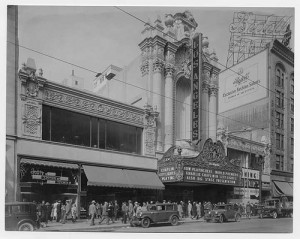The City of Tomorrow That Preserves Yesterday’s History
By Eveline Morel | August 8th, 2012 | Category: L.A. Art & Culture | Comments Off on The City of Tomorrow That Preserves Yesterday’s History Hailed as the quintessential City of Tomorrow, Los Angeles has always attracted daring dreamers and innovators looking for a testing-ground of new concepts and dissatisfied searchers looking for a new way of life. A launching pad for many ideas and industries and in constant search of the Next Big Thing, this City of the Future is also very self-conscious about its past, resolute in its historic preservation effort.
Hailed as the quintessential City of Tomorrow, Los Angeles has always attracted daring dreamers and innovators looking for a testing-ground of new concepts and dissatisfied searchers looking for a new way of life. A launching pad for many ideas and industries and in constant search of the Next Big Thing, this City of the Future is also very self-conscious about its past, resolute in its historic preservation effort.
L.A.’s history is deeply tied to its architecture. A city created from the visions and ideals of succeeding waves of newcomers, its buildings provide a tangible chronology of the economic and social development, as well as a historical outline of each generation’s beliefs and aspirations. The diversity of images captured in L.A.’s architecture reflects the shifts in ideology of each generation.
LA’s architectural history continues to be shaped by two opposing forces: on one hand, a conscious effort by local government and active historic preservation groups to maintain its past and a sense of place; on the other hand, an aggressive, present-focused, profit-driven real estate development that constitutes Southern California’s most lucrative large industry and seeks to dominate city politics and economics.
Ironically, a large part of the history that L.A. is so careful about preserving is largely founded upon fiction rather than a factual past. Lasting myths around the “Spanish” past—embroidered upon by popular writers of the 1880s and 1890s to satisfy romantic dreams and elevate a sense of meaning—were further carried forth by professional advertisers to increase tourism and real estate sales. This romantic Spanish past, quite removed from the historic Mexican settlements of the early 1800s, has become such a central theme in L.A.’s essence and has merged so well with the emotional needs of Angelenos that we have, over the generations, shaped the city’s substance to reflect the fiction.
Hollywood’s illusion machine added its own fuel to the architectural fantasy prevalent in L.A. during the 20s. The movies provided the perfect way of coping with post-war unsettling changes and insecurities, creating fantasy worlds that the public could escape to, and setting models of style and culture to emulate. Entrepreneurs outdid each other converting neighborhood theaters into ornate, luxurious temples to the imagination, oracles of style and values. The Orpheum, The Egyptian, Los Angeles Theater, the Mayan . . . are just a few of the surviving examples. During the 20s and 30s, the motion pictures, oil and aircraft industries fueled L.A.’s dynamic economic and population expansion, creating a new aura of glamour. Radio, motion pictures, and automobiles served as disseminators of L.A.’s ideals to the rest of the country and into the national culture.
Interestingly enough, it was the 1920s that saw the first historical preservation efforts as Mrs. Christine Sterling launched a one-woman campaign to preserve the “Spanish” heritage of Olvera Street. Two remaining buildings were saved, and a one-block street was converted to a Mexican marketplace as a tourist attraction. Other attempts to memorialize this idealized “Spanish” graciousness led to several adobes being restored beyond recognition of their original structure, whereas some restorations in the 30s (the Sanchez Adobe and Andres Pico house) chose historical accuracy over fictional ideals. But the greatest monument to L.A.’s fictional Spanish heritage and the imaginary ideal of the Spanish hacienda is the 1925 Casa de Adobe, built by the Hispanic Society of California to serve as a representative replica of an early 1800s hacienda. Not finding an example that suited the vision, it turned into an amalgam of copied features from different “historical” buildings.
By the turn of the century, having cycled through a succession of architectural imagery, ranging from fanciful images of Exotica, the Italianate, Arts & Crafts, Ranch Style, and the ever-present Spanish Colonial, Angelenos (of whom nearly one million were now native-born) recognized that L.A.’s formative phase had ended, and became self-consciously aware of their urban environment, studying it in a proprietary, critical fashion, reassessing their relation to place, and taking stock of its past and future.
This collective reassessment emerged during the mid-60s, reaching a crescendo in the mid-70s and early 80s, developing into a social and cultural movement. Press articles and books appeared on the subject, local colleges started offering courses on Los Angeles history and cultural heritage, and a concerted restoration effort developed. In 1962 concerned citizens formed the Cultural Heritage Preservation Board to preserve and restore historical landmarks and buildings, bringing L.A. to the forefront of the national historical preservation movement and aiding the passage of the National Preservation Act of 1966. The year 1978 saw the creation of the L.A. Conservancy, whose 6,000+ membership is far greater than any other historic preservation group in the U.S. Historic preservation, no longer just for “old ladies in tennis shoes,” is also economically desirable: a boost to property values.
For the city that reinvents itself, preservation along with sustainability and environmentalism has become the new ideal of the 21st century, visions that will shape L.A.’s ever-evolving architectural landscape. As for the Spanish heritage, now it’s part of history.
Check out the Octavio Carlin fashion editorial photographed at historical landmark the LA Theater.








